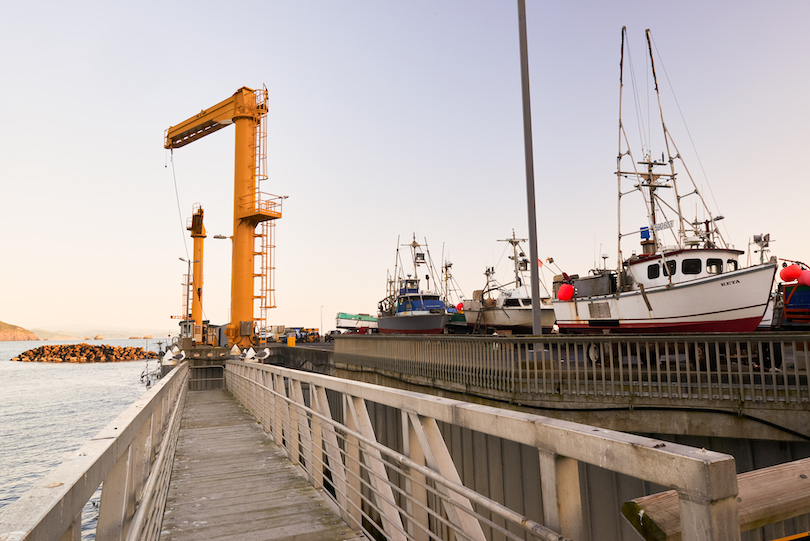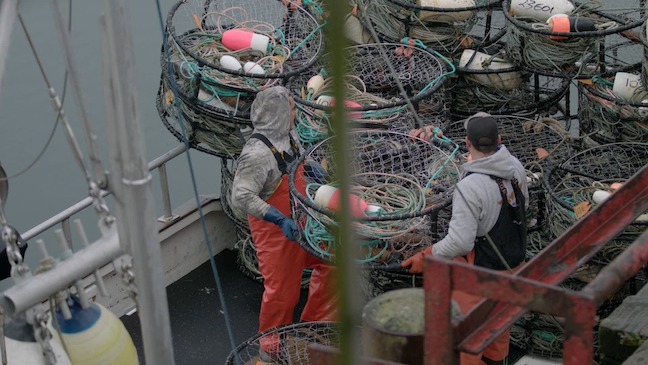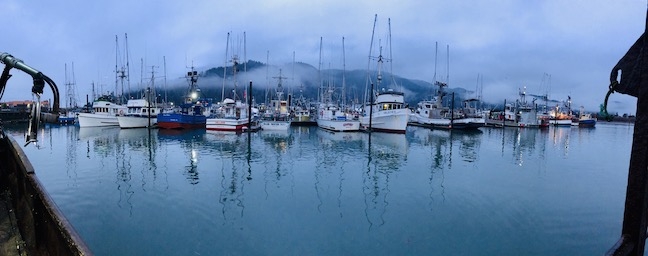Brand Story – Ninety percent of seafood sold to Oregon Coast residents and visitors is sourced elsewhere, hurting the state and the environment
Nothing captures the Oregon Coast experience like tucking into a meal of fresh seafood with an ocean view. Millions of visitors arrive each year for moments like these, unaware that much of the food on their plates, and 90 percent of seafood sold to Oregon Coast residents and visitors, is sourced elsewhere. The Oregon Coast Visitors Association launched the Ocean Cluster Initiative to help keep more seafood local, a straightforward goal with the ability to transform Oregon and the planet.
When Covid-19 disrupted supply chains, the coast’s largest processor-distributor stopped buying and exporting seafood. Imports halted too, hurting restaurants and food stores. Despite the fact that local supply and demand were still perfectly intact, a lack of hyperlocal infrastructure left the fishing industry unable to provide seafood to its own communities.

The Oregon Coast Visitors Association witnessed how modern commodity market practices had made the region dependent on long supply chains, crippling its ability to feed local populations and visitors in times of crisis.
Using funding awarded by the USDA in 2021, it launched the Ocean Cluster Initiative with the vision of creating a regional seafood and aquaculture industry that regenerates the environment and nourishes communities.
As the seafood industry rebuilds, the Visitors Association hopes it can trade the status quo for a hyperlocal approach built on shared infrastructure and buying-distribution networks for harvesters and buyers.

“Oregon seafood is the coast’s unique food proposition. When the food we sell is not from Oregon, we immediately lose much of the money we just earned from our marketing efforts,” explains Marcus Hinz, Executive Director, Oregon Coast Visitors Association. “Planes are flying out with Oregon seafood as other planes fly in with the seafood we are selling. Plane by plane we are increasing the planet’s carbon footprint and shortchanging our communities and visitors.”
The world’s oceans and the seafood industry itself have suffered under the current model. Two decades ago, Oregon State University Researcher Francis Chan discovered incidents of low or no oxygen water, which has expanded to the size of the EU and affected at least 500 coastal locales worldwide.
In 2013, after a pool of warm water appeared off the Pacific Coast, the Pacific Coast Federation of Fishermen’s Associations, representing 900 family-owned fishing boats, sued to hold fossil fuel companies accountable for the detrimental effects of climate change on their industry. Known as The Blob, this water mass grew to more than 2,000 miles long, running from the Mexican border to Alaska.
“Clearly, we live under threat of a quickly changing global climate, and the money we spend could either contribute to solutions or accelerate the rate of change,” Hinz adds.
Against a backdrop of geopolitical crises (Russian seafood sanctions being a fitting example), natural disasters and climate change, the Ocean Cluster Initiative wants processing and distribution facilities near every fishing port along the roughly 360-mile-long Oregon Coast.
 Port Orford
Port Orford
Today, a large portion of the state’s seafood is processed in China due to cheap, skilled labor or sent inland to be processed and packaged before returning to the coast.
Additionally, a myriad of decades-old regulations designed to protect the integrity of seafood products hinder a local market by, for example, preventing fishermen from selling directly to restaurants or processing their catch at sea.
“I believe the biggest challenge is political will to change the status quo. There needs to be the will to create additional infrastructure along the coast to make it possible for seafood to stay here,” Hinz explains. “If there’s nowhere to store it, it won’t stay here. We need hyperlocal storage, hyperlocal processing and hyperlocal distribution. Until that infrastructure exists, local seafood is not even possible.”
And a lack of local seafood means a lack of seafood-based entrepreneurship and innovation by chefs and startups, further undermining economic potential.
For now, the Ocean Cluster Initiative is stepping up to support a new coworking space in Newport: the Yaquina Lab. The facility offers shared space and equipment for small seafood businesses to lighten their expenses, and also taps into emerging distribution networks and food hubs that make it easier to get fish from the coast to the rest of Oregon.
A study by Oregon-based Hans Radtke, Ph.D. Natural Resource Economist, and Shannon Davis, The Research Group, confirms that a higher penetration of local catch in local Oregon Coast markets increases added value, creating more jobs and reducing blue carbon footprint by lowering transportation requirements (Radtke, Hans & Davis, Shannon. 2022. “Oregon Coast Synthesized Seafood Distribution Chain Model Project”).
Its research estimates that if the Oregon Coast increases local usage by 10 percent, it would generate an additional $90 million for local economies. Radtke identifies groundfish, pelagic fish, pink shrimp and Dungeness crab as harvested species best diverted for local seafood consumption—something he believes the industry can achieve with the right infrastructure, consumer awareness campaigns, workforce training and supportive management policies.

Over the last three years the majority of Oregon Coast seafood exports to Canada, followed by Japan, China, Ukraine and Nigeria, while the majority of imports are coming from China, Canada and India, followed by Chile, Indonesia
Radtke, who has been involved in the economics of seafood for over four decades and currently serves on the Governor’s Council of Economic Advisors, says that certain exports increase opportunity while others simply waste it: “For Pacific whiting the market is overseas. It works well for international trade. Pink shrimp, on the other hand, is not developed enough in Oregon. It’s a great product that should be on everyone’s plate instead of the farm-raised stuff we buy from Thailand.
“The trend towards commodity markets is related to the consolidation and centralization of processing businesses,” Radtke adds. “There are examples of existing Oregon Coast small business processors that emphasize sales to local restaurants and seafood markets, but they face challenges in fish supplies, portion processing, packaging, cold, storage and transportation.”
Local Ocean, a grill and market in Newport Harbor, knows those challenges well.
“It’s really hard. Local Ocean buys direct from boats, which brings (literally) tons of logistical challenges and regulatory and reporting requirements,” explains owner and Ocean Cluster Initiative member Laura Anderson. “Once a boat is scheduled, we offload the fish at the docks, fillet each by hand, deal with carcass waste and, at times, vac-pac and freeze in boxes. The labor and cost for this is above and beyond what the average restaurant can manage. And the important part is, they should not have to.”
This is where the Yaquina Lab comes in, helping the Ocean Cluster Initiative support businesses in their effort to keep seafood local.
“The fisherman simply can’t do it all,” she warns, referencing owner-operated seafood businesses in which one or two people handle fishing, harvesting, fish buying-selling, processing, sales, bookkeeping and distribution.
 Fishermen in Brookings
Fishermen in Brookings
In addition to creating food security and high-paid job opportunities, local seafood carries higher nutritional benefits for local consumers. When Oregon’s seafood gets exported to the highest paying customers around the world, lower quality, unsustainable seafood replaces it to feed rural, less affluent communities.
“A new study measures the environmental impact of food production against nutrition [Koehn, Z.J. et al. 2022. “The Role of Seafood in Sustainable Diets” Environ. Res. Lett. 17 035003]. The bottom line is that sustainably harvested wild seafood provides some of the best bang for the environmental buck,” Anderson explains. “Oregon seafood is richer in protein, fiber, Omega-3s, minerals and essential vitamins than other food choices. And the carbon footprint of most wild seafood is considerably less than other meat sources. So, why would we want to export this incredible value and natural resource away from our communities?”
According to Radtke & The Research Group’s findings, consumers are willing to pay a premium for quality, traceable consumer products from sustainably managed and socially responsible fisheries. Buyers care about a product’s story, as illustrated by farmers’ markets and food cooperatives, which promote connections between farmer and consumer.
“We have a vision that Oregon’s food from the sea is recognized as among the most valuable natural capital on the planet, and local and state governments support a local food system that retains seafood value in the coastal economies and celebrates its extraordinary significance to the state and the region,” Anderson concludes.
“In the future, we want resilient communities in Oregon—food-secure communities, healthy communities. This is all consistent with keeping local seafood local.”
Learn more at www.oregonseafoodmatters.org
Brand stories are paid content articles that allow Oregon Business advertisers to share news about their organizations and engage with readers on business and public policy issues. The stories are produced in house by the Oregon Business marketing department. For more information, contact associate publisher Courtney Kutzman.



